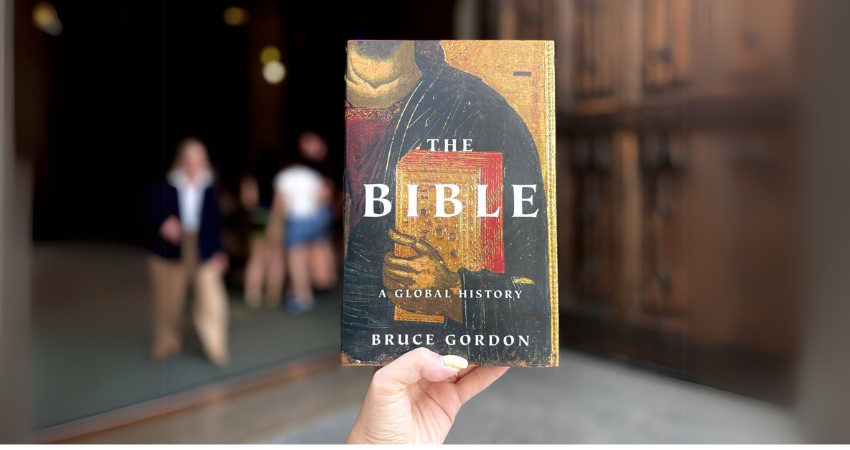Review: The Bible: A Global History, Bruce Gordon, Basic Books
The global history of the Bible could be said to begin with the Great Commission: Jesus sends his disciples to, theoretically, the corners of the globe to spread the gospel. And that gospel is contained in the Scriptures. This is in contrast to Judaism, from which Christianity springs, which, while welcoming of foreigners, doesn’t actively pursue them – Christians will put evangelism at the core of their faith.
Their Bible doesn’t stay in the synagogue either, Bruce Gordon tells us. Paul’s letters and the biographies we call gospels are carried around like sets of instructions, written in everyday language. (This utility is testified to by all the fragments found in ancient rubbish tips.) Letters are copied and circulated and read out at meetings.
At first the Bible doesn’t even exist as a monolithic thing. But the codex is a new piece of technology that allows for readers to bundle texts together. Readers can move around in the text (unlike in a scroll) and they can move around with the codex in their pocket. This also allows portions of the Jewish Bible to be bundled with these new texts, indicating an equivalence of value.
Gordon is keen to let us know that the Bible is experienced in ways other than just reading the text. In the Middle Ages, while the laity don’t read the Bible, it is everywhere: preached, seen in pictorial form on walls and in windows, heard in plays. In contrast to early church times, the Bible as a physical object is costly, precise, intricate, bejewelled even. As such, it also becomes the desire of elite collectors and treasure hunters. It is kept in monasteries and used in the worship service but rarely gets into the hands of the laity. By the fifth century it is, like the host in the eucharist, a symbol of power.
In the Middle Ages, the Bible is also experienced through other books, such as books of liturgical readings which are as bejewelled and venerated as the Bible itself. Ironically, for a book so central to the faith, most can’t understand it. But though the Bible itself is in Latin, there are books of biblical stories, written in the vernacular.
Illustrations will help Luther’s Bible get its message across, while the new printing technologies bring down the prices. Lavishly illustrated Bibles make a comeback in the 1800s, but the illustrations are Eurocentric, suggesting that Christianity is a European religion, and that its dissemination is part of a ‘civilising’ project that needs to be spread globally.
The Reformation is thought of as the great democratisation of the Bible, but Gordon reminds us that translations abound before Luther and Tyndale, even if the translations are not entirely welcomed by the hierarchy. Not only is there Wycliffe’s, but there are numerous German translations, some of which Luther uses for his own work.
But, indeed, the Reformation prioritises Scripture over Church. At the Council of Trent, the Catholic Church is quick to emphasise that authority rests in both Scripture and Church. Meanwhile, the Bible truly goes global. Laity can read it, and it travels to the Americas and to Asia. The discovery of the Americas challenges notions of how universal the Bible is, but the Spanish soon use it, at least, to justify conversion, conquest and domination. But there, at least initially, the Bible remains a symbol of power, untranslated.
The Reformation produces the King James Bible, which becomes a pseudo-original text in the eyes of some, such is its power. Yet it isn’t seen as up-to-the-minute initially. Some critics judge it as clumsy. And there are hiccups: in 1631 the ‘Wicked Bible’ is produced, so-called because it contains the erroneously rendered line ‘Thou shalt commit adultery’. The printers have to explain the mistake to the king himself, but only after the error has gone undetected for a year. One wonders what its readers get up to in the meantime.
Translation work explodes in the 1800s. The American Bible Society is established, and they have printed one million Bibles by 1860. But against the image of Americans being perpetually dazzled by the new-fangled, the KJV continues to outsell newer versions by the wagonload. The British Bible Society organises itself on pragmatic business principles – reach is the goal and doctrine less important. (The members assume, like Luther, that simply reading the Bible provides clarity.) There is a plethora of national Bible societies, busily translating. As they were in the Reformation, Catholic leaders are suspicious. In the Middle East, Americans come up against the reality of already existing Orthodox churches, who the Americans, typically, characterise as needing conversion anyway.
Because Christianity, especially in the eighteenth and nineteenth centuries, is tied to Western ‘civilisation’, either deliberately or inadvertently, potential Indigenous converts are not always persuaded. Some translations are problematic because they merge dialects, pleasing few. There is also a challenge finding the right terms for the divine, and for theological concepts. This bedevils efforts in Africa, Asia and the Americas. Yet, as in Australia, translators will have the secondary success of preserving Indigenous languages.
There is speculation Christianity may have arrived in China in the first century. Later, a version arrives in the seventh century, but the major work is done by the Jesuits. However, Bible translation seems almost impossible at first, due to the influence of Confucianism and the lack of equivalences for biblical ideas, including God. They only have success in the 1800s. Similar problems are thrown up in Africa, where, in the nineteenth century numerous translations are made. Yet there are arguments within church circles whether traditional deity names are appropriate. In the traditions of Tanzania, the supreme creator is female. In Zulu, a name chosen by translators for God refers to an ancestral spirit.
The problems of translation are not unique to modernity, considering the Vulgate, Jerome’s Latin version, is a translation. By the Middle Ages scholars are aware of its deficiencies, and competing and corrupted versions abound. One corrective they come up with is the marginal commentary – like hypertext, says Gordon. But monks also go back to the Hebrew.*
Another issue is personal interpretation. While Luther thinks the Bible’s meaning is clear, he also puts himself forward as the authoritative interpreter, especially in the controversial case of ‘This is my body’, in which, as Bill Clinton’s lawyer infamously argued in relation to sex, there is dispute over what the definition of ‘is’ is.
The Bible is always personal in a way, but Gordon emphasises the importance of the guidance of the Spirit in Puritan theology. For the Puritans, the Bible mediates a personal relationship with God, independent of liturgy and different to scholarly appreciation of the Bible. It is their desire to interpret the Bible without interference from the institutionalised church that drives them on their epic journey.
In turn, Native Americans, who the Puritans evangelise, interpret the Bible their own way. The Algonquian people incorporate the Bible into their own belief systems, ‘on their own terms’, Gordon writes. Moreover, they use the Bible to preach back to the colonists, especially in relation to violence and the annexation of land. Similarly, Gordon tells a more nuanced version of missions. Linking too directly evangelisation and colonialism risks disempowering Indigenous peoples and ignores the evidence that Indigenous leaders, on many occasions, decide where, how and by whom the gospel will be preached.
In China and Africa, because of the long association of the Bible and colonisation, some theorists argue that the Bible must be amended or supplemented with other writings. President Xi of China now says the Bible needs to be rewritten to conform to Chinese Communist Party ideals.
Gordon necessarily covers much ground in this book (without burdening the reader in the slightest). There are a few omissions. He doesn’t get into the intriguing area of modern Bible smuggling, and there is little about modern manifestations of the Bible – youth versions, comic versions, the Lego Bible – and its influence on popular culture, through film, music and television. He also doesn’t go into the way the Bible informs or hinders current environmental concerns, something particularly relevant in Pacific communities. But then, he can’t include everything, I guess.
His last areas of focus are the rise of Pentecostalism and the church in Africa and China. Pentecostals have a literal belief in the Bible supercharged by an injection of Spirit-inspired interpretation, challenging traditional churches. In Africa, which could be said to be the emerging centre of global Christianity (in contrast to its restrained position in China), personal study of the Bible only strengthens the popularity and authority of the churches. There, the Bible is used to distance themselves from European and colonial legacies (including, to the consternation of some in the West, more recent liberal Western ideas). In some ways, African Christianity, says Gordon, takes up a more ancient approach to the Bible. While the Bible is sometimes used as a talisman or book of spells – even, bizarrely at football matches – there is also, in comparison to the West, a more literal acceptance of the world of supernatural forces that the Bible describes.

While today Christians globally continue to be inspired by study of the Bible to acts of service and personal growth, if the contemporary United States, with its strange conflation of Bible and right-wing gun culture, is an indication, the challenges of interpretation continue. *For more on the intricacies of translation, see John Barton’s excellent book The Word (Penguin, 2022)
Nick Mattiske blogs on books at coburgreviewofbooks.wordpress.com and is the illustrator of Thoughts That Feel So Big.












